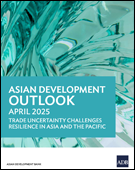 Asian Development Outlook (ADO) April 2025South Asia underwent a slowdown, amid delays in public investment in India. South Asia’s gross domestic product (GDP) is estimated at 6.0% in fiscal year (FY) 2025 and 6.2% in FY2026. Bangladesh’s GDP growth is estimated at 3.6% in FY2025, amid a projected improvement in manufacturing. In Bhutan, growth in 2025 will rise to 8.5% behind expansion in industry and hydroelectric production. India’s GDP will reach 6.7% in FY2025 amid a strong outlook for services and manufacturing. In Maldives, growth will moderate to 5.0% in FY2025 amid slowdowns in construction. GDP growth in Nepal in FY2025 will be at 4.4% with expansion expected in agriculture. Sri Lanka’s GDP will moderate to 3.9% in FY2025 as recovery in garments manufacturing continues. In Southeast Asia, Myanmar will experience modest GDP growth of 1.1% in 2025, premised on growth in industry and services. Author: Asian Development Bank Year: 2025 Download Tags: ADB, Bangladesh, Bhutan, India, Maldives, Myanmar, Nepal, Sri Lanka, Manufacturing, Agriculture, Services 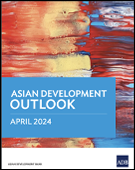 Asian Development Outlook (ADO) April 2024Robust growth is forecast for South Asia in fiscal year (FY) 2024, driven by strong gains in investments, consumption, and the electronics and services sectors. Gross domestic product (GDP) is estimated at 6.3% in FY2024 and 6.6% in FY2025 in South Asia. In Bangladesh, GDP growth is projected at 6.1% in FY2024 behind the growth of traditional low-end garments. Bhutan's projected GDP is at 4.4% given major developments in the country's hydropower sector. In India, GDP is forecast at 7.0% in FY2024, after a strong momentum in manufacturing and services in FY2023 and with exports expected to pick up in FY2025 with the rise in global growth. Growth in Maldives is estimated at 5.4% in FY2024 supported by tourism and construction. Nepal is estimated to grow at 3.6% backed by hydroelectric production and domestic demand. Amid recovery efforts in Sri Lanka, modest growth at 1.9% is forecast for the country in FY2024. In Southeast Asia, Myanmar’s GDP is projected to remain low at 1.2%. Author: Asian Development Bank Year: 2024 Download Tags: South Asia, ADB, Hydropower, Tourism, Bangladesh, Bhutan, India, Maldives, Myanmar, Nepal, Sri Lanka Open for Business: How Maldives Overcame the COVID-19 CrisisThe economy of Maldives, being reliant on tourism, went into recession due to border closures and travel restrictions during the coronavirus (COVID-19) pandemic. The pandemic called attention to the need for Maldives to diversify its economy to reduce short-term macroeconomic volatility. In addition, Maldives stands to benefit from setting up regional maritime connectivity for strengthening food trade with other South Asian countries. Author: Abdulla Ali, Elisabetta Gentile, Macrina Mallari, Thiam Hee Ng Year: 2023 Download Tags: ADB, Tourism, COVID-19, Maldives  Expanding Opportunities: Toward Inclusive GrowthGDP in South Asia is estimated to grow at 5.6% in fiscal year FY2023 and 5.9% in FY2024, backed by the recovery in services and lower commodity prices. GDP growth in Bangladesh will decelerate to 5.2% in FY2022-2023 due to global economic uncertainty, before recovering to 6.2% in FY2024. In Bhutan, GDP is projected to expand at 4.5% in FY2022-2023 as the further reopening of borders support growth in industry and services. GDP growth in India will moderate to 6.3% in FY2023-2024 following slower growth in consumption. Maldives is seeing a return to the tourism sector's pre-pandemic levels with GDP growth projections in FY2023 at 6.6%. Growth in Nepal will slow to 4.1% in FY2023 following import restrictions, before rising to 4.9% in FY2024. In Sri Lanka, amid fiscal and external imbalances, GDP growth is estimated at -4.3% in FY2023 and 1.2% FY2024. In Southeast Asia, the Myanmar Economic Monitor projects Myanmar's economic recovery accelerating to 3% in the year to September 2023 following growth in industry and services. Author: World Bank Year: 2023 Download Tags: WB, Bangladesh, Bhutan, Sri Lanka, Services, India, Maldives, Myanmar, Nepal Basic Statistics 2023Basic Statistics presents data on development indicators tracking progress toward the Sustainable Development Goals. The publication includes new data for development indicators for 46 economies in Asia and the Pacific, including those for the seven South Asia Subregional Economic Cooperation countries: Bangladesh, Bhutan, India, Maldives, Myanmar, Nepal, and Sri Lanka. Author: Asian Development Bank Year: 2023 Download Tags: Bangladesh, Bhutan, India, Myanmar, Maldives, Nepal, Sri Lanka, Sustainable Development Goals ADB Annual Report 2022In 2022, under the operational priority of Fostering Regional Cooperation and Integration, the Asian Development Bank (ADB) provided support for a $143-million program in Bangladesh to construct integrated customs stations and land ports at border-crossings to help increase trade volumes among South Asia Subregional Economic Cooperation (SASEC) countries. In India, ADB committed $300 million to upgrade district roads in Assam, which will reduce travel time to SASEC corridors. ADB is also supporting a nonsovereign loan that would improve communication network capacity and mobile services in Maldives. Author: Asian Development Bank Year: 2023 Download Tags: ADB, SASEC, Maldives, India, Bangladesh, Road 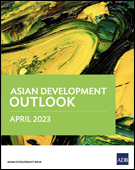 Asian Development Outlook (ADO) April 2023South Asia is projected to grow faster than other subregions in Asia, with real gross domestic product (GDP) estimated at 5.5% in fiscal year (FY) 2023 and 6.1 in FY2024. Growth within South Asia is expected to vary, with India projected to grow by 6.4% in FY2023 and 6.7% in FY2024 behind strong domestic demand. In Bangladesh, GDP growth is estimated at 5.3% in FY2023 owing to global economic disruptions and 6.5% in FY2024. In Bhutan, hydropower production will push up growth to 4.6% in FY2023 and 4.2% in FY2024. Growth in Maldives is estimated at 7.1% in FY2023 and 6.9% in FY2024, supported by a boom in tourism and construction. In Nepal, growth will slow to 4.1% this year before picking up in FY2024 at 5.0% with a recovery in tourism and infrastructure. Sri Lanka is projected to contract at -3.0% in FY2023 before recovering to 1.3% in FY2024 premised on debt relief and key reforms. In Southeast Asia, Myanmar's GDP will rise moderately to 2.8% in FY2023 and 3.2% in FY2024. Author: Asian Development Bank Year: 2023 Download Tags: South Asia, Hydropower, ADB, Bangladesh, Bhutan, India, Maldives, Myanmar, Nepal, Sri Lanka 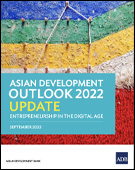 Asian Development Outlook (ADO) 2022 Update: Entrepreneurship in the Digital AgeGrowth forecast in South Asia is projected at 6.5% in fiscal year (FY) 2022 and FY2023. In Bangladesh, gross domestic product (GDP) growth is projected at 7.2% in FY2022 and 6.6% in FY2023, reflecting lower consumption spending. Growth in Bhutan is forecast to grow at 4.5% in FY2022 and 4.0% in FY2023 as government investment continues as a key driver of growth. In India, weaker than expected global demand is expected to affect growth, projected at 7.0% for FY2022 and 7.2% for FY2023. GDP growth in Maldives is forecast at 8.2% in FY2022 and 10.4% in FY2023 with continued tourism arrivals. In Nepal, GDP is projected at 5.8% in FY2022 and 4.7% in FY2023, affected in part by needed policy tightening to address rapid rise in imports. Contractions are projected for Sri Lanka, -8.8% in FY2022 and -3.3% in FY2023, likely resulting from severe macroeconomic challenges, including the impact of the ongoing crisis. In Southeast Asia, Myanmar's GDP is forecast at 2.0% in FY2022 and 2.6% in FY2023 owing to an improvement in economic activity. Author: Asian Development Bank Year: 2022 Download Tags: ADB, Bangladesh, Bhutan, India, Maldives, Myanmar, Nepal  Reshaping Norms: A New Way ForwardSouth Asian countries are emerging from coronavirus (COVID-19) pandemic burdened by high inflation and fiscal imbalances, as well as external shocks. In Bangladesh, gross domestic product (GDP) is projected to increase by 6.4% in fiscal year (FY) 2021-2022 and 6.7% in FY2022-2023. In Bhutan, FY2021-2022 growth is estimated at 4.4% and FY2022-2023 growth at 4.7%, with the expected return of international tourists and migrant workers from India. In India, FY2022-2023 growth is projected at 8%, slightly below last year’s rate. Economic recovery in Maldives will stay strong in 2022, with real GDP growth expected to grow by 8.5% in 2022 and 9.1% in 2023. In Nepal, tourism has yet to recover, with growth projected at 3.7% in FY2021-2022 and 4.1% in FY2022-2023. Hydropower in Nepal is providing a natural hedge against increases in crude oil-based energy prices. Growth in Sri Lanka is hampered by a series of shocks amid high debt, with 2022 growth projected at 2.4%. Author: World Bank Year: 2022 Download Tags: WB, South Asia, Bangladesh, Bhutan, India, Maldives, Nepal, Sri Lanka Basic Statistics 2022Basic Statistics presents economic, environmental, and social indicators used to track progress toward the Sustainable Development Goals. The publication includes new data for development indicators for 46 economies in Asia and Pacific, including those for the seven South Asia Subregional Economic Cooperation countries: Bangladesh, Bhutan, India, Maldives, Myanmar, Nepal, and Sri Lanka. Author: Asian Development Bank Year: 2022 Download Tags: Bangladesh, Bhutan, India, Maldives, Myanmar, Nepal, Sri Lanka, Trade, Sustainable Development Goals, Renewable Energy  Asian Development Outlook (ADO) 2022: Mobilizing Taxes for DevelopmentGrowth in South Asia is projected to remain strong at 7.0% in FY2022 and 7.4% in FY2023 as the region’s economies try to catch up to pre-pandemic levels. In Bangladesh gross domestic product (GDP) growth is projected at 6.9% in FY2022. Growth in FY2023, projected at 7.1%, will be driven by private consumption. Bhutan is forecast to grow at 4.5% in FY2022. Growth will accelerate to 7.5% in FY2023 with the reopening of international tourism in the country. India is forecast to grow at 7.5% in FY2022 and 8.0% in FY2023, buoyed by strong investment growth. GDP growth in Maldives is forecast at 11.0% in FY2022 and 12.0% in FY2023 with continued tourism arrivals. In Nepal, fiscal stimulus and wider vaccination coverage will support growth, projected at 3.9% in FY2022 and 5.0% in FY2023. Sri Lanka's growth is forecast to slow to 2.4% in FY2022 and pick up to 2.5% in FY2023 amid low foreign exchange reserves. In Southeast Asia, Myanmar’s economy is forecast to contract in FY 2022 on protracted political instability. Myanmar GDP is forecast at -0.3% in FY2022 and 2.6% in FY2023. Author: Asian Development Bank Year: 2022 Download Tags: ADB, Bangladesh, Bhutan, India, Nepal, Sri Lanka, Maldives, Myanmar Asian Development Outlook 2021 UpdateEconomic growth in South Asia is projected at 8.8% in 2021 while the outlook for next year has been raised to 7.0% from 6.6%. In Bangladesh, growth in fiscal year (FY) 2022 is projected to strengthen though still below pre-coronavirus pandemic levels. In Bhutan, gross domestic product (GDP) in FY2021 is estimated to have contracted by 3.4%; growth is forecast to rebound to 3.7% in FY2022. The projection for India is downgraded to 10.0% from the earlier projection of 11.0% in FY2021, while the outlook for FY2022 improved to 7.5% from 7.0%. Tourist arrivals in Maldives increased by 33.4% year on year in 2021. In Nepal, GDP growth is estimated at 2.3% in FY2021. In Sri Lanka, GDP growth forecasts are revised down to 3.4% in 2021 with risks from fresh pandemic outbreak and currency related stress. Author: Asian Development Bank Year: 2021 Download Tags: ADB, COVID-19, South Asia, Bangladesh, Bhutan, India, Maldives, Sri Lanka Basic Statistics 2021Basic Statistics 2021 presents development indicators—tracking the progress made by countries in achieving the Sustainable Development Goals. It includes data for 46 economies in Asia and the Pacific, including those for the seven South Asia Subregional Economic Cooperation countries: Bangladesh, Bhutan, India, Maldives, Myanmar, Nepal, and Sri Lanka. Author: Asian Development Bank Year: 2021 Download Tags: Bangladesh, Bhutan, India, Maldives, Myanmar, Nepal, Sri Lanka, Trade, Sustainable Development Goals, Renewable Energy 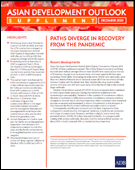 Asian Development Outlook (ADO) 2020 Supplement: Paths Diverge in Recovery from the PandemicThis publication provides updated economic forecasts for Asia and the Pacific. In South Asia, the earlier forecast of 6.8% contraction in 2020 is upgraded to 6.1%. Growth in South Asia is expected to return in 2021 at 7.2%. This is in line with improved prospects for India, where contraction is projected at 8.0% in 2020 and growth is projected at 8.0% in 2021. In Bangladesh, growth in exports and remittances backed economic activity. In Bhutan, the impact of the coronavirus disease (COVID-19) pandemic is expected to be greater than projected. Travel demand remains weak in Maldives and is hampering recovery. In Nepal, a persistent rise in COVID-19 infections holds back demand. Resurgent outbreaks in Sri Lanka’s export and tourist markets are expected to worsen contraction in 2020. Author: Asian Development Bank Year: 2020 Download Tags: South Asia, India, Bhutan, Sri Lanka, Nepal, Bangladesh, Maldives, Tourism, COVID-19, Export Summary of Proceedings of the 53rd ADB Annual Meeting of the Board of GovernorsThe Fifty-Third Annual Meeting of the Board of Governors of the Asian Development Bank (ADB) was held virtually in two stages in May and September 2020. Ms. Nirmala Sitharaman, Minister of Finance, India, called for the establishing of a regular South Asia Subregional Economic Cooperation (SASEC) meeting of finance ministers by 2021 to further strengthen regional cooperation. Mr. Ibrahim Ameer, Finance Minister, Maldives, noted how ADB has assisted Maldives through the SASEC National Single Window Project. Author: Asian Development Bank Year: 2020 Download Tags: SASEC, ADB, India, Maldives, Regional Cooperation, National Single Window Basic Statistics 2020Basic Statistics presents select economic, environmental, and social indicators used to track progress toward the Sustainable Development Goals. It includes new data for development indicators for 46 economies in the Asia and Pacific region, including those for the seven South Asia Subregional Economic Cooperation countries: Bangladesh, Bhutan, India, Maldives, Myanmar, Nepal, and Sri Lanka. Author: Asian Development Bank Year: 2020 Download Tags: Sustainable Development Goals, Bangladesh, Bhutan, India, Maldives, Myanmar, Nepal, Sri Lanka Asian Development Outlook (ADO) 2020: What Drives Innovation in Asia?Growth in developing Asia is forecast to slow to 2.2% in fiscal year (FY) 2020 due to the effects of the global health emergency. In South Asia, growth will decelerate to 4.1% in FY2020 and rebound to 6.0% in FY2021 following a projected revival in India. Bangladesh is projected to grow by 7.8% this fiscal year and 8.0% in FY2021. GDP growth in Bhutan, despite lower tourist arrivals, will accelerate on high government spending. Growth in Maldives and Sri Lanka will be constrained this year due to weaker tourism. In Nepal, the outlook is for moderating growth. In Southeast Asia, Myanmar growth is expected to slow in FY2020 and pick up in FY2021. Author: Asian Development Bank Year: 2020 Download Tags: ADB, Bangladesh, Bhutan, India, Maldives, Myanmar, Nepal, Sri Lanka, Tourism, FDI Achieving Energy Security in Asia: Diversification, Integration and Policy ImplicationsThis publication reviews the status of energy security in Asia. In South Asia, countries face challenges in achieving energy security and climate goals. India and Bangladesh, for instance, face rising energy import bills while Maldives depends on oil products. The book suggests that countries and regions can achieve energy security through energy cooperation and diversification. This would lead to economic growth and poverty reduction, as well as mitigate energy security risks from climate change. Author: Asian Development Bank Institute and World Scientific Year: 2019 Download Tags: WB, India, Bangladesh, Maldives, Energy, Climate Change Asian Development Outlook (ADO) 2019 Supplement, December: Growth Slows Further in Developing Asia’s GiantsDeveloping Asia's gross domestic product is projected to grow by 5.2% both in 2019 and 2020 as a slowing of global economic activity tempers regional growth, according to the Asian Development Outlook (ADO) 2019 Supplement. In South Asia, growth forecasts have been lowered to 6.1% in 2020. Strong remittances in Bangladesh will raise domestic demand, while in Bhutan, hydropower production rose to 3.1% in Q1 of FY2020 (ending 30 June 2020). Growth in India is expected to recover to 6.5% in 2020 with government policy measures, such as a corporate tax cutt and policy rate reduction. In Maldives, tourism remains strong. Foreign direct investments surged in Nepal while a recovery in economic activity is projected in Sri Lanka. Author: Asian Development Bank Year: 2019 Download Tags: ADB, South Asia, Hydropower, Tourism, Investment, Bangladesh, Bhutan, Maldives, Nepal, Sri Lanka South Asia: Shifting Outlook Calls For Steadfast ReformsGrowth in South Asia is projected to rise to 7.0% in 2020. To create more and better jobs, the region needs to further strengthen reforms. Growth in Bangladesh is expected to remain strong at around 8.0% in fiscal year (FY) 2019, led by private consumption and investment. In Bhutan, economic activity will pick up to around 6.0% in FY2020, supported by private consumption. In India, gross domestic product (GDP) growth slowed to 6.8% in FY2018/2019. Economic activity in Nepal remains robust as FY2018/2019 growth reached 7.1%. In Maldives, growth has been supported by increasing tourist arrivals. Economic activity in Sri Lanka is projected to recover as the tourism sector stabilizes. Author: International Monetary Fund Year: 2019 Download Tags: Bangladesh, Bhutan, India, Maldives, Nepal, Sri Lanka, Investment, Jobs, Tourism Borders without Barriers: Facilitating Trade in SASEC CountriesBorders without Barriers presents an analysis of the state of trade facilitation in member countries of the South Asia Subregional Economic Cooperation (SASEC) program. The book includes an analysis of the state of trade facilitation in Bangladesh, Bhutan, India, Nepal, and Sri Lanka, as well as in Maldives and Myanmar. It identifies trade facilitation priorities in SASEC countries: implementation of trade facilitation agreements and other conventions; logistics and infrastructure development and regulatory reforms; coordinated border management; and institutions and capacity development. Author: Asian Development Bank Year: 2019 Download Tags: ADB, SASEC, Trade Facilitation Agreement, Bangladesh, Bhutan, India, Maldives, Myanmar, Nepal, Sri Lanka, ADB RCI 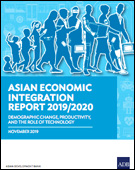 Asian Economic Integration Report 2019/2020: Demographic Change, Productivity, and the Role of TechnologyThis report reviews economic cooperation and integration in Asia and the Pacific. It reports that in 2018, the South Asia Subregional Economic Cooperation (SASEC) focused on reducing gaps in multimodal connectivity among its member countries. By the end of 2018, 52 ADB-financed projects worth $11.36 billion had been committed to SASEC projects, with an additional $106.44 million in 81 technical assistance grants. SASEC nodal officials and working groups met in Singapore in March 2018 to update the SASEC operational plan. The operational plan identified 77 projects ($45.6 billion) to be financed by SASEC members, ADB, and development partners. A holistic approach under the operational plan will build transport links with Southeast Asia and East Asia and expand regional trade markets. Author: Asian Development Bank Year: 2019 Download Tags: ADB, Regional Cooperation, SASEC, Trade Facilitation, Transport, Bangladesh, Bhutan, India, Maldives, Myanmar, Nepal, Sri Lanka Maritime Cooperation in SASEC: South Asia Subregional Economic CooperationMost South Asia Subregional Economic Cooperation (SASEC) countries rely on maritime transport for international trade. Stronger maritime relations are crucial to achieve the economic growth potential for the subregion. This report looks at how countries can strengthen international trade by improving maritime cooperation among the SASEC countries, comprised of Bangladesh, Bhutan, India, Maldives, Myanmar, Nepal, and Sri Lanka. It gives an overview of the SASEC maritime sector and identifies collaboration initiatives that could address key challenges. Author: Asian Development Bank Year: 2019 Download Tags: Transport, Trade Facilitation, Bangladesh, Bhutan, India, Maldives, Myanmar, Nepal, Sri Lanka, ADB RCI Asian Development Outlook (ADO) 2019 Update: Fostering Growth and Inclusion in Asia's CitiesGrowth in developing Asia remains strong despite the slowing down of international trade and a weakening of investments. In South Asia, growth momentum has slowed, with growth forecasts lowered to 6.2% for 2019 and retained at 6.7% for 2020. Growth in India has softened but is expected to bounce back to 7.2% in 2020. Bangladesh and Nepal performed better than projected. Bhutan’s growth slowed to 5.3% in fiscal year (FY) 2019 due to a decline in hydroelectric generation. Growth projection for FY2020 is retained at 6.0%. In Sri Lanka, growth forecast has been lowered for 2019 and 2020. Forecasts for Maldives is retained as tourist arrivals increased in the first half of 2019. In Southeast Asia, growth projections for Myanmar has been retained. Author: Asian Development Bank Year: 2019 Download Tags: Hydropower, ADB, Bangladesh, Bhutan, India, Maldives, Myanmar, Nepal, Sri Lanka Basic Statistics 2019Basic Statistics presents select economic, environmental, and social indicators used to track progress toward the Sustainable Development Goals. It includes indicators for development indicators for 46 economies in the Asia and Pacific region, including those for the seven SASEC countries: Bangladesh, Bhutan, India, Maldives, Myanmar, Nepal, and Sri Lanka. Author: Asian Development Bank Year: 2019 Download Tags: Bangladesh, Bhutan, India, Maldives, Myanmar, Nepal, Sri Lanka, Trade, Sustainable Development Goals, Energy Economic and Social Survey of Asia and the Pacific 2019: Ambitions beyond GrowthThe Asia-Pacific region needs an estimated $1.5 trillion per year to end poverty and hunger, provide basic health care, quality education, enabling infrastructure, and clean energy for all, and for climate action and living in harmony with nature. Available public and private resources make these ambitions affordable for most countries in the region. However, development partnerships and regional cooperation are needed for all countries to achieve these “ambitions beyond growth.” Author: United Nations Economic and Social Commission for Asia and the Pacific Year: 2019 Download Tags: Sustainable Development Goals, Bangladesh, Bhutan, India, Nepal, Maldives, Myanmar, Sri Lanka, Trade, Energy Renewable Capacity Statistics 2019This report provides renewable energy statistics for 2009–2018. It includes figures on total renewable energy capacity installed and connected by energy source (hydropower, wind energy, solar energy, etc.). It gives figures for capacity per region and per country, including those for Bangladesh, Bhutan, India, Maldives, Myanmar, Nepal, and Sri Lanka. Author: International Renewable Energy Agency Year: 2019 Download Tags: Renewable Energy, Bangladesh, Bhutan, India, Maldives, Myanmar, Nepal Asian Development Outlook (ADO) 2019: Strengthening Disaster ResilienceDeveloping Asia is projected to grow at 5.7% in 2019 and 5.6% in 2020. South Asia is projected to bounce back in 2019 and 2020 from the previous year’s slowdown. India’s growth is expected to pick up to 7.2% in 2019 (from 7.0% in the previous year) on recovery in agriculture and strong domestic demand. Bangladesh is projected to grow by 8.0% in 2019. Bhutan is expecting modest growth while the outlook for Maldives is for growth to moderate. Nepal should expect stable growth in 2019 while Sri Lanka is projected to recover moderately. Inflation in South Asia is projected to rise to 4.7% in 2019. Growth should pick up in Myanmar in Southeast Asia. Author: Asian Development Bank Year: 2019 Download Tags: ADB, South Asia, Bangladesh, Bhutan, India, Myanmar, Maldives, Nepal, Sri Lanka Sustaining Harbor Operation and Maintenance in MaldivesImproved inter-island connectivity plays a key role to achieving inclusive growth in Maldives. This Asian Development Bank brief explores investments in harbor infrastructure, operation, and maintenance in Maldives, and looks to understand the opportunities these provide, especially for women, and for poor and vulnerable groups in the country. Author: Andri Heriawan Year: 2018 Download Tags: ADB, Maldives, Transport Asian Development Outlook 2018 Supplement: The Outlook Firms as Trade Conflict PausesGrowth forecasts for developing Asia stand at 5.8% in 2019. South Asia is still the fastest-growing subregion in developing Asia, while 2019 forecasts are revised down marginally at 7.1%. Bangladesh maintains its growth momentum with the expansion of exports and remittances. Growth in Bhutan has moderated while tourist arrivals grew strongly in Maldives. India exports are increasing along with the country’s industrial and agricultural output. GDP in Sri Lanka grew by 3.7% amid revived private consumption. In Nepal, exports surged by 16.1% while remittances grew to a record $2.1 billion. Author: Asian Development Bank Year: 2018 Download Tags: ADB, Bangladesh, Bhutan, India, Maldives, Nepal, Sri Lanka  Road Map for the National Single Window in MaldivesThis publication outlines key steps to launching Maldives’ national single window (NSW) platform. An archipelago, Maldives’ geographic dispersion contributes to logistics and border control challenges. An NSW on a digital platform will allow all trade stakeholders to submit and access information on importing and exporting goods in a single place. It will streamline international trade procedures, minimize the time, effort, and resources needed to conduct trade, while helping the government maintain requisite controls. With current bottlenecks to trade in Maldives leading to some of the highest import and export costs in the South Asian subregion, leveraging on information and communications technology will help the country overcome physical and logistical barriers to trade, and significantly improve efficiency. More efficient trade procedures can lower the costs of imports, exports, and goods, and help drive economic growth. Author: Asian Development Bank Year: 2018 Download Tags: Maldives, National Single Window, ADB RCI Key Indicators for Asia and the Pacific 2018This report presents the latest economic, financial, social, and environmental statistics for the 48 regional members of the Asian Development Bank (ADB). In 2017, foreign direct investment flows to developing Asia was stable, with 8.8% going to South Asia; energy gains were made in five of six countries in South Asia; and starting a business continues become easier in most developing ADB member economies following lowered regulatory costs and simplified compliance procedures. Nepal and Armenia experienced the most rapid annual growth rate at 7.5%, while India witnessed a 6.7% growth in GDP. Author: Asian Development Bank Year: 2018 Download Tags: ADB, Energy, Transport, Bangladesh, Bhutan, India, Maldives, Nepal, Southeast Asia, Sri Lanka Risk Management in Maldives: Sharing Practical Experience and Lessons LearnedMaldives is implementing reforms to improve risk management controls and to strengthen its trade environment. Risk management aims to determine which goods need to be examined in detail when entering a country. As government agencies improve service delivery, traders will benefit from reduced time to import and export goods, increased predictability of services, and greater ease of doing business. This report shows that improvements to risk management processes to deliver operational and economic gains in Maldives can be replicated across South Asia. Author: Asian Development Bank Year: 2018 Download Tags: Customs, Maldives, SASEC, Trade, ADB RCI Embracing the E-commerce Revolution in Asia and the PacificAsia is the world’s largest e-commerce marketplace. In South Asia, India has the largest e-commerce market at $33 billion in 2017. Maldives, Bhutan, and Sri Lanka lead the subregion in terms of percentage of the population with access to the internet. This report introduces a framework for analyzing the quality of e-commerce development in the Asia-Pacific region and discusses lessons learned regarding e-commerce development. The framework incorporates economic factors, institutional environment, and social acceptance to assess e-commerce development and suggest the way forward. Author: Asian Development Bank, United Nations Economic and Social Commission for Asia and the Pacific Year: 2018 Download Tags: ADB, ICT, Trade, UNESCAP, Maldives, Bhutan, Sri Lanka Asian Development Outlook 2018 Supplement: The Outlook Remains Stable South Asia continues to be the fastest expanding subregion, with growth on track to achieve forecasts of 7.0% in 2018 and 7.2% in 2019. India will meet April forecasts of 7.3% in 2018 and 7.6% in 2019. Owing to strong agricultural growth in Bangladesh and industry growth in Nepal, 2018 GDP growth in the two countries surpassed earlier forecasts. Decline in construction slowed Sri Lanka’s economic growth to 3.2% while hydropower production was lower than forecast in Bhutan. Cement, wood, and metal imports grew in Maldives. Author: Asian Development Bank Year: 2018 Download Tags: ADB, Bangladesh, Bhutan, Energy, Hydropower, India, Maldives, Nepal, Sri Lanka Basic Statistics 2018Basic Statistics presents development indicators for 45 economies in the Asia and Pacific region, including those for the seven SASEC countries, Bangladesh, Bhutan, India, Maldives, Myanmar, Nepal, and Sri Lanka. It presents selected core indicators such as international and national poverty rates, inflation, and current account balance. It also presents information on indicators related to land, population, sustainable development goals, national accounts, money, balance of payments, reserves, external debt, and central government finance. Author: Asian Development Bank Year: 2018 Download Tags: Energy, ADB, Trade, Sustainable Development Goals, Bangladesh, Bhutan, India, Maldives, Myanmar, Nepal, Sri Lanka Asian Development Outlook (ADO) 2018: How Technology Affects JobsDeveloping Asia is forecast to expand by 6.0% in 2018 and 5.9% in 2019. Growth in South Asia is expected to be revived after a two-year slowdown. India is expected to bounce back to 7.3% in 2018 and 7.6% in 2019 owing to the effects of tax and banking reforms and corporate deleveraging. Growth will be strong in the rest of South Asia, with a forecast of 7.0% in 2018 and 7.2% in 2019, but expansion will be affected in Bangladesh and Sri Lanka following a need to carry out revenue-enhancing fiscal reform and to strengthen economic policy. Inflation forecast in South Asia is 4.7% in 2018 and raised to 5.1% in 2019. Author: Asian Development Bank Year: 2018 Download Tags: ADB, Bangladesh, Bhutan, India, Employment, Jobs, Maldives, Myanmar, Nepal, Sri Lanka, Technology Renewable Capacity Statistics 2018This publication provides statistics on renewable power generation capacity for the last decade. It gives figures for global capacity, capacity per region, and capacity per country, including those for Bangladesh, Bhutan, India, Maldives, Myanmar, Nepal, and Sri Lanka. Figures include those for total energy generation capacity, total renewable capacity, and capacity by energy source (hydropower, wind energy, solar energy, etc.). Author: International Renewable Energy Agency Year: 2018 Download Tags: Hydropower, Renewable Energy, Bangladesh, Bhutan, India, Maldives, Myanmar, Nepal, Sri Lanka Harmonizing Electricity Laws in South AsiaMany in South Asia face electricity shortages that affect their socioeconomic development. But the region has a large hydropower potential and other energy resources that may be harnessed to drive growth in the region. This report looks at legal, regulatory, technical, and commercial requirements for energy trade to advance in the region, and gives recommendations for implementing the South Asian Association for Regional Cooperation Framework Agreement on Energy Trade. Author: Asian Development Bank and the South Asian Association for Regional Cooperation in Law Year: 2017 Download Tags: Bangladesh, Bhutan, Energy, Harmonisation, India, Industrialization, Maldives, Nepal, Regional Cooperation, South Asia, Sri Lanka, Trade, ADB RCI Digital Trade Facilitation in Asia and the Pacific: Studies in Trade, Investment and InnovationDigital trade facilitation is reducing trade costs for developing economies, allowing them to use trade as an engine of growth and sustainable development. This report provides an overview of trade facilitation and paperless trade implementation in the Asia-Pacific region. It analyzes the impact on trade costs of trade facilitation measures and reviews paperless trade provisions in recent regional trade agreements. Among the countries surveyed are Bangladesh, Bhutan, India, Maldives, Nepal, and Sri Lanka. Author: United Nations Economic and Social Commission for Asia and the Pacific Year: 2017 Download Tags: Bangladesh, Bhutan, India, Maldives, Nepal, Sri Lanka, Trade Facilitation Agreement, WTO Least Developed Countries Report 2017This report focuses on transformational energy access for the LDCs, where 62% of people have no access to electricity. It makes a case for trade in electricity, such as the 2014 South Asian Association for Regional Cooperation framework agreement for regional cooperation on electricity among Afghanistan, Bangladesh, Bhutan, India, Maldives, Nepal, Pakistan, and Sri Lanka. International and regional trade in electricity could help lower electricity prices, mitigate power shocks, relieve shortages, and facilitate the transition to cleaner energy. Author: United Nations Conference on Trade and Development Year: 2017 Download Tags: Bangladesh, Bhutan, Maldives, Nepal, Sri Lanka, Energy, Least Developed Countries, Trade 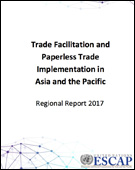 Trade Facilitation and Paperless Trade Implementation in Asia and the Pacific - Regional Report 2017Paperless trade reduces trade costs and enables trade to drive growth and sustainable development. This report shares results of the global survey on trade facilitation and paperless trade implementation, covering 44 countries in Asia and the Pacific. It covers 47 trade facilitation measures, including those involving general trade, paperless trade, cross-border paperless trade, transit, and trade for small and medium-sized enterprises. The report gives an overview of trade facilitation implementation in South and Southwest Asia, and includes Bangladesh, India, and Myanmar in its analysis of transit measures in Asia and the Pacific. Author: United Nations Economic and Social Commission for Asia and the Pacific Year: 2017 Download Tags: UNESCAP, Bangladesh, India, Least Developed Countries, Maldives, Myanmar, Small and Medium Enterprise, Trade Facilitation Agreement, Transport Facilitation, WTO Key Indicators for Asia and the Pacific 2017This report gives the latest statistics on economic, financial, environmental, and Sustainable Development Goal (SDG) indicators for the 48 regional members of the Asian Development Bank, including up-to-date figures on energy, trade, and transport. In 2016, Asia and the Pacific accounted for 40.9% of global gross domestic product (GDP). While foreign direct investment (FDI) flows declined in East Asia and Southeast Asia in 2016, FDI flows to South Asia remained stable. The average number of days required to start a business in South Asia was 16. Energy consumption is also expected to increase in the coming decades owing to increasing GDP per capita and an increase in the use of energy-consuming goods. Author: Asian Development Bank Year: 2017 Download Tags: ADB, Energy, Transport, Bangladesh, Bhutan, India, Maldives, Nepal, Southeast Asia, Sri Lanka Asian Development Outlook (ADO) Supplement: A Firmer Growth Outlook for AsiaGrowth forecast for developing Asia for 2018 is downgraded to 5.8%, from projections in the Asian Development Outlook 2017 Update in September 2017. Forecasts for the region’s inflation rates have been retained at 2.9% for 2018. For South Asia, growth outlook for 2018 is retained at 7.0%. India’s gross domestic product (GDP) growth rebounded to 6.3% in FY2017 (ending 31 March 2018), led by manufacturing. Bangladesh showed higher GDP growth for FY2017 (ended 30 June 2017) than was previously estimated. Bhutan showed stronger growth than forecast, supported by transport and communication services and construction. Growth projections for Maldives, Nepal, and Sri Lanka are in line with those in the Update. Author: Asian Development Bank Year: 2017 Download Tags: ADB, India, Bangladesh, Bhutan, Maldives, Nepal, Sri Lanka, Manufacturing Asian Development Bank and the Maldives: Fact SheetThis Asian Development Bank (ADB) Fact Sheet provides social and economic indicators on Maldives, and information on ADB operations and contact details. ADB is helping Maldives upgrade commercial and domestic harbors, ensure power supply reliability, boost economic growth, and reduce regional disparities in living standards. Projects in sustainable energy development are helping Maldives achieve carbon neutrality and reduce high fuel costs. Since 1978, ADB has approved 29 loans and grants totaling $248.53 million for Maldives, and has funded 67 technical assistance projects totaling $29.65 million. Author: Asian Development Bank Year: 2017 Download Tags: ADB, Maldives, Energy, Transport, Development, Sustainability The Internet of Things in the Power Sector: Opportunities in Asia and the PacificAsia’s power sector struggles to upgrade power systems and keep up with growing demand. The Internet of Things (IoT) has the potential to transform the power sector by optimizing operations and lowering costs for consumers. The power sector is already reaping the benefits of adoption of smart meters and smart thermostats, two consumer-oriented IoT applications. The Asian Development Bank has committed to smart grid projects in India, through a Green Energy Corridor and Grid Strengthening Project, and Maldives, through the Preparing Outer Islands for Sustainable Energy Development (Phase 1). Author: Arun Ramamurthy and Pramod Jain Year: 2017 Download Tags: Energy, ADB, India, Maldives, Sustainability 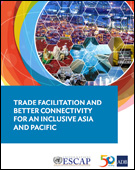 Trade Facilitation and Better Connectivity for an Inclusive Asia and PacificThis report investigates the evolution of trade costs, examines trade facilitation and paperless trade implementation, and highlights key initiatives in South Asia, including efforts by members of the South Asia Subregional Economic Cooperation (SASEC). The SASEC Trade Facilitation and Transport Working Group agreed to expand assistance to trade facilitation through technical assistance to support more efficient, transparent, secure, and service-oriented processing of cross-border trade across South Asia. Through 2025, the SASEC connectivity agenda will be better aligned with the frameworks of South Asian Association for Regional Cooperation and the Bengal Initiative for Multi-Sectoral Technical and Economic Cooperation. To help establish a trade and transport facilitation monitoring mechanism, Bangladesh, Bhutan, and Nepal conducted studies that reviewed trade and transport procedures, analyzed bottlenecks, and gave recommendations on trade and transport facilitation. Author: Asian Development Bank and United Nations Economic and Social Commission for Asia and the Pacific Year: 2017 Download Tags: ADB, Bangladesh, Bhutan, BIMSTEC, Maldives, Nepal, SAARC, India, Myanmar, SASEC, South Asia, Sri Lanka, Trade Facilitation, Transport, UNESCAP, ADB RCI 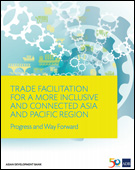 Trade Facilitation for a More Inclusive and Connected Asia and Pacific Region: Progress and Way ForwardThis report gives an overview of assessments from the 2017 global survey on trade facilitation and paperless trade in Asia and the Pacific. It looks at the implementation of trade facilitation and paperless trade measures in 44 countries in Asia and the Pacific, including how the South Asia Subregional Economic Cooperation Trade Facilitation Strategic Framework promotes development by deepening regional cooperation. The Framework covers national and subregional projects in Customs harmonization, improving cross-border facilities, and transport facilitation. The Framework also supports regulatory reforms and the development of the National Single Window Customs management system in Bangladesh, Bhutan, Maldives, and Nepal. Author: Asian Development Bank and United Nations Economic and Social Commission for Asia and the Pacific Year: 2017 Download Tags: ADB, Bangladesh, Bhutan, BIMSTEC, Maldives, Nepal, Regional Cooperation, Regional Integration, SAARC, SASEC, Standards Harmonization, Trade Facilitation, Trade Facilitation Agreement, WTO, UNESCAP, ADB RCI 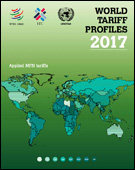 World Tariff Profiles 2017World Tariff Profiles is a joint publication of the World Trade Organization (WTO), International Trade Centre, and the United Nations Conference on Trade and Development devoted to information on market access for goods. It contains comprehensive data on tariffs and non-tariff measures imposed by over 170 countries and Customs territories. This year’s edition takes a close look at export diversification, analyzing to what extent economies have diversified their exports over time. Many countries make it a policy to diversify exports to obtain bigger market shares. An overview of export diversification shows how India, Myanmar, Sri Lanka, Bangladesh, and Bhutan have grown in the last two decades. Bangladesh in particular has achieved significant increase in terms of both product coverage and market reach. Author: World Trade Organization, International Trade Centre, and the United Nations Conference on Trade and Development Year: 2017 Download Tags: Bangladesh, Bhutan, Export, India, Maldives, Myanmar, Nepal, Sri Lanka, Tariffs, Trade, UNCTAD, WTO World Trade Statistical Review 2017The World Trade Statistical Review looks at the last 10 years and examines the latest developments in world trade, with a detailed analysis of the most recent trends for trade in goods and services. The book gives information on the participation of India, Bangladesh, and other South Asian economies in world trade, and highlights trends in the use of trade-facilitating measures. It also gives information on the implementation of the WTO Trade Facilitation Agreement and regional trade agreements, such as the South Asian Free Trade Arrangement. Author: World Trade Organization Year: 2017 Download Tags: Export, Least Developed Countries, Aid for Trade, SAFTA, South Asia, Trade Facilitation, WTO, Bangladesh, Bhutan, India, Maldives, Myanmar, Nepal, Sri Lanka Win-Win: How International Trade Can Help Meet the Sustainable Development GoalsThis book aims to demonstrate to policy makers how international trade can contribute to achieving the Sustainable Development Goals (SDGs). Trade can promote income growth, which can then support sustainable development. In addition, there are also direct links between trade and sustainable development, such as trade’s effect on the price and availability of health, education, energy, and other important services. This book maps out a triple-win scenario where good trade policy spurs international trade, contributes to development-friendly outcomes, and helps achieve the SDGs. Author: Matthias Helble and Ben Shepherd, eds. Year: 2017 Download Tags: Bangladesh, India, Maldives, Nepal, Services, South Asia, Sustainability, Sustainable Development Goals Regional Cooperation for Sustainable Energy in Asia and the PacificCountries in the Asia-Pacific region face multiple energy-related challenges, which are driving transformation of energy systems. Addressing these energy challenges is an integral part of implementing the 2030 Agenda for Sustainable Development, including ensuring access to affordable, reliable, sustainable, and modern energy for all. This report analyzes challenges in the Asia-Pacific region and its efforts to accelerate the energy transition to achieve Sustainable Development Goal 7. Author: United Nations Economic and Social Commission for Asia and the Pacific Year: 2017 Download Tags: Asia-Pacific, Energy, Sustainability, Sustainable Development Goals, UNESCAP, Bangladesh, Bhutan, India, Maldives, Myanmar, Nepal, Sri Lanka Eradicating Poverty and Promoting Prosperity in a Changing Asia-PacificThis report explores five long-term trends in the Asia-Pacific region that will shape approaches to poverty alleviation and the prospects for achieving prosperity: regional economic cooperation and integration; rural–urban transitions; demographic changes; ICT access and connectivity; and demand for natural resources. It examines the changing development context in South Asian and other economies. It also looks at opportunities created by regional cooperation and integration that intend to bring about shared economic benefits. Author: United Nations Economic and Social Commission for Asia and the Pacific, Asian Development Bank, United Nations Development Programme Year: 2017 Download Tags: ADB, Connectivity, ICT, Regional Cooperation, Sustainability, UNESCAP, UNDP, Bangladesh, Bhutan, India, Maldives, Nepal, Sri Lanka 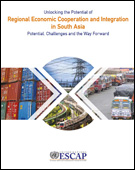 Unlocking the Potential of Regional Economic Cooperation and Integration in South AsiaAt a modest 6% of total trade, intraregional trade in South Asia stands at less than one third of its full potential. Trade barriers and inadequate infrastructure have cost South Asia over US $54 billion per year in lost export opportunities. With 309 million people living on less than $1.90 a day—the largest concentration of poverty in the world—South Asia should urgently pursue broad-based regional economic cooperation that could enable effective responses to the subregion’s developmental challenges. This report examines the state of economic integration in South Asia and identifies potential areas for further strengthening subregional linkages. It provides recommendations on policy actions to increase market integration, improve connectivity, boost investment in infrastructure development, and tackle shared vulnerabilities and risks. It calls for the consolidation and upgrading of existing trade and investment cooperation initiatives into a South Asia Comprehensive Economic Partnership. Author: United Nations Economic and Social Commission for Asia and the Pacific Year: 2017 Download Tags: BIMSTEC, Investment, Regional Cooperation, SAARC, South Asia, Sustainability, Sustainable Development, Trade, UNESCAP, Bangladesh, Bhutan, India, Maldives, Myanmar, Nepal, Sri Lanka 2016 Development Effectiveness ReviewThe Development Effectiveness Review tracks development progress in Asia and the Pacific and monitors the Asian Development Bank’s (ADB) effectiveness 2010-2016. For South Asia, ADB shares results in regional cooperation, energy, and road and rail transport. ADB also approved $4.4 billion in financing for projects in South Asia during 2016. The Review includes details of ongoing and newly approved projects. Author: Asian Development Bank Year: 2017 Download Tags: ADB, Asia-Pacific, Development, Poverty Reduction, Regional Cooperation, Regional Integration, Roads, Transport, Bangladesh, Bhutan, India, Maldives, Nepal, Sri Lanka The Little Data Book on Information and Communication TechnologyThis book presents quick indicators for more than 200 countries showing data on key indicators of information and communications technology (ICT), including access, quality, affordability, efficiency, sustainability, and applications. It includes data for Bangladesh, Bhutan, India, Maldives, Myanmar, Nepal, and Sri Lanka. Author: World Bank and International Telecommunications Union Year: 2017 Download Tags: Bangladesh, Bhutan, ICT, India, Maldives, Myanmar, Nepal, Sri Lanka, South Asia, WB 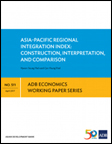 Asia-Pacific Regional Integration Index: Construction, Interpretation, and ComparisonDeeper regional integration expands markets, helps maximize the efficiency of resource allocation, and boosts productivity and investment opportunities, all serving stronger economies. This study proposes a regional integration index for Asia and the Pacific, the Asia-Pacific Regional Integration Index (APRII), comprising 26 indicators that measure various aspects of regional integration along six dimensions: trade and investment integration, money and finance integration, regional value chains, infrastructure and connectivity, free movement of people, and institutional and social integration. In the overall APRII, India ranks 14th—scoring closely to the Asia region integration average of 0.473—and scores highest on regional value chains and institutional and social integration. Nepal ranks 15th, scoring highest on regional value chains and trade and investment integration. Bangladesh and Sri Lanka rank 18th and 20th, respectively, and score highest on regional value chains. Maldives ranks 21st, scoring highest on free movement of people. Myanmar and Bhutan ranks 26th and 27th, and both score highest on trade and investment integration. In the overall regional integration indexes of selected Asian subregions, South Asia ranks 4th. Author: Hyeon-seung Huh, Cyn-Young Park Year: 2017 Download Tags: Regional Integration, Nepal, Bangladesh, Maldives, Myanmar, Bhutan Basic Statistics 2017Basic Statistics 2017 contains development indicators for 45 economies in the Asia and Pacific Region, including the seven SASEC countries, Bangladesh, Bhutan, India, Maldives, Myanmar, Nepal, and Sri Lanka. It includes selected indicators of the Sustainable Development Goals (SDGs) such as the proportion of population living below $1.90 (PPP) a day, proportion of population with access to electricity, renewable energy share in the total final energy consumption, unemployment rate, total official flows for infrastructure, and trade balance. Author: Asian Development Bank Year: 2017 Download Tags: Energy, Trade Facilitation, Transport, Sustainable Development Goals, Bangladesh, Bhutan, India, Maldives, Myanmar, Nepal, Sri Lanka Implications of Brexit to the Asia-Pacific Region: with a Focus on Least Developed Countries (Trade Insights: Issue No. 20)This issue of Trade Insights, published by United Nations Economic and Social Commission for Asia and the Pacific, discusses how possible Brexit scenarios could adversely affect least developed countries in the Asia-Pacific region. Simulation results show that potential reduction in exports to the United Kingdom for fish, clothes, textiles, footwear, and other key items can range from 16% to 50% of their current export value. According to the study, countries heavily exposed to Brexit-induced risks must analyze the extent of such impact and engage the United Kingdom in discussions in order to limit negative impact. Author: Louis Graham, Arun Jacob, and Anders K. Møller Year: 2017 Download Tags: Asia-Pacific, Least Developed Countries, South Asia, Trade, UNESCAP, India, Bangladesh, Maldives, Myanmar, Nepal, Sri Lanka 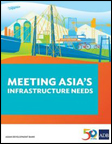 Meeting Asia's Infrastructure NeedsThis report estimates infrastructure investment needs in Asia and the Pacific for 2016-2030, updating the Asian Development Bank's assessment for 2010-2020 published in 2009. The report places developing Asia's investment needs at $26 trillion to maintain its growth momentum, eradicate poverty, and respond to climate change. While developing Asia's infrastructure, including its transport network and electricity generation capacity, has improved significantly over the years, it remains far from adequate – lack of reliable power supply continues to constrain economic growth and traffic congestion results in lost productivity, wasted fuel, and human stress. The report recommends $14.7 trillion investment for power and $8.4 trillion for transport. South Asia requires investments valued at 8.8% of gross domestic product. Author: Asian Development Bank Year: 2017 Download Tags: Asia, South Asia, Energy, Transport, Bangladesh, Bhutan, ADB, India, Maldives, Myanmar, Sri Lanka, Nepal 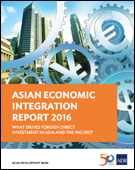 Asian Economic Integration Report 2016: What Drives Foreign Direct Investment in Asia and the Pacific?The 2016 Asian Economic Integration Report reviews regional economic cooperation and integration in Asia and the Pacific, amidst the rising global uncertainty following the United Kingdom’s referendum on leaving the European Union and the U.S. election, slower-than-expected global economic recovery, and ongoing economic restructuring in the People’s Republic of China and growth moderation. Asia faces heightened uncertainty–trade growth decelerated in 2015, falling to 2.3% in 2015; subregional trade linkages continue to strengthen, but inter-subregional trade linkages weakened; and non-tariff measures have become major obstacles to trade. In South Asia, SASEC cooperation has improved access to key markets in smaller economies, reduced real trade costs and behind-the-border barriers to stimulate investment; and enabled cross-border power exchanges to ensure power supply affordability, reliability, and overall grid stability. However, the SASEC agenda needs to be framed within wider integration processes taking place in Asia in the next decade to enhance economic linkages, and harness the full potential of Asian integration. Author: Asian Development Bank Year: 2016 Download Tags: ADB, ASEAN, Asia-Pacific, Development, FDI, Free Trade Agreements, Regional Cooperation, Regional Integration, SASEC, Trade Facilitation, UNCTAD, Bangladesh, Bhutan, India, Maldives, Nepal, Sri Lanka 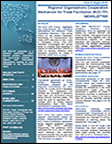 Regional Organizations Cooperation Mechanism for Trade Facilitation (ROC-TF) Newsletter: Issue X, August 2016This issue highlights the framework agreement on cross-border paperless trade facilitation adopted by the United Nations Regional Commission for Asia-Pacific, which will facilitate the exchange of electronic trade data and documents between participating United Nations Economic and Social Commission for Asia and the Pacific (UNESCAP) member states, and the 2016 Global Facilitation Partnership for Transportation and Trade forum. The latterencourages the private sector to mobilize expertise in support of trade facilitation reforms to develop effective trade facilitation solutions for small and medium-sized enterprises. The Newsletter also features SASEC-supported initiatives, including the launch of the new Maldives Customs Service training module on Customs valuation, as well as data collection for establishing the Trade and Transport Facilitation Monitoring baseline in Bhutan. The ROC-TF newsletter is a biannual publication featuring updates, publications and forthcoming activities of regional and international organizations working on trade facilitation in the Asia-Pacific region, including the Asian Development Bank, the World Customs Organization, and UNESCAP. Author: United Nations Economic and Social Commission for Asia and the Pacific Year: 2016 Download Tags: Trade Facilitation, ICT, Maldives, Customs, SASEC, Customs Valuation, Bhutan 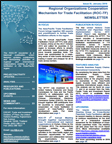 Regional Organizations Cooperation Mechanism for Trade Facilitation, Issue IX, January 2016This biannual publication features updates, publications and forthcoming activities of regional and international organizations working on trade facilitation in the Asia-Pacific region, including the Asian Development Bank (ADB), the World Customs Organization (WCO), and the United Nations Economic and Social Commission for Asia and the Pacific. It includes highlights of the Asia Pacific Trade Facilitation Forum 2015 and the Train-the-Trainer Workshops on Customs Valuation through Post Clearance Audit being jointly implemented by the WCO and ADB in the 6 SASEC member countries. This issue also features an analysis on achieving seamless supply chains through implementing comprehensive and pragmatic national trade facilitation reform programs. Author: UNESCAP Year: 2016 Download Tags: Trade Facilitation, Asia-Pacific, WCO, ADB, UNESCAP, Customs Valuation, Nepal, Bangladesh, Bhutan, India, Maldives, Sri Lanka Asian Development Outlook 2015 Supplement: Growth Holds Its Own in Developing AsiaThis Supplement maintains growth forecast for developing Asia at 5.8% in 2015 and 6.0% in 2016. In South Asia, economic outlook remains optimistic, with the region on track to meet Update projections of 6.9% in 2015 and 7.3% in 2016. India's economic expansion balances a slowdown in Bhutan—owing to weaker sales of hydropower—and the Maldives in 2015, and in Nepal in 2016—due to unfavorable weather and unforeseen delays in earthquake-related reconstruction. Growth projections for Bangladesh and Sri Lanka remain in line with those in the Asian Development Outlook Update. Author: Asian Development Bank Year: 2015 Download Tags: ADB, South Asia, Bangladesh, Bhutan, India, Maldives, Nepal, Sri Lanka 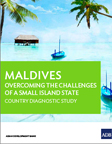 Maldives: Overcoming the Challenges of a Small Island State – Country Diagnostic StudyThe Maldives has propelled itself to middle-income status despite the geographic constraints and challenges of a small-island state. It has one of the lowest poverty rates in South Asia, although wide regional disparities in poverty rates and high-income inequality continue to be a concern. Growth – primarily driven by the tourism sector – has also been vulnerable to external shocks. As the Maldives moves toward a more sustainable and inclusive growth strategy, transport infrastructure is critical to help address the country’s connectivity issue and reduce the cost of doing business. This report identifies the critical constraints to inclusive growth in the Maldives and provides policy recommendations to sustain economic growth and hasten poverty reduction. Author: Asian Development Bank Year: 2015 Download Tags: Maldives, Small Island Developing States, Transport, Connectivity, Policy, Poverty Reduction, South Asia, Tourism Cross-Border Electricity Cooperation in South AsiaStrengthening cross-border electricity cooperation in South Asia can be part of the solution for providing adequate and reliable electricity. This World Bank Policy Research Working Paper reviews the status of cross-border electricity cooperation in South Asia, identifies key regional-level barriers to expand cross-border cooperation and trade in South Asia, and discusses the extent to which current domestic sector policies impede greater cross-border electricity cooperation. Finally, the findings offer policy recommendations on increased cross-border trade and cooperation. Author: Anoop Singh, Tooraj Jamasb, Rabindra Nepal, and Michael Toman Year: 2015 Download Tags: Energy, Regional Cooperation, Regional Trade, Bangladesh, Bhutan, India, Maldives, Nepal, South Asia, Sri Lanka, Trade, Trade Policy, WB 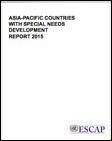 Asia-Pacific Countries with Special Needs Development Report 2015In the Asia-Pacific region, 36 out of the 58 economies are considered countries with special needs (CSN), which include least developed countries (LDC), landlocked developing countries, and small island developing States. This report highlights important areas that should be addressed as key priorities by CSNs such as economic diversification, external trade, South-South cooperation, and official development assistance including foreign direct investment. Bhutan and Nepal met the criteria for graduation from LDC status as of 2013. Other countries such as Bangladesh have a good chance of meeting the graduation criteria by 2018. Among the Small island developing States, Maldives is considered a success story in broadband internet connectivity. The results of this research show that Asia-Pacific CSNs must choose their paths to diversification carefully, depending on country circumstances. Author: United Nations Economic and Social Commission for Asia and the Pacific Year: 2015 Download Tags: Asia-Pacific, Least Developed Countries, Small Island Developing States, Bangladesh, Bhutan, Energy, FDI, Investment, Maldives, Nepal, Trade, Transport, UNESCAP World Tariff Profiles 2014This statistical yearbook devoted to market access for goods contains a comprehensive compilation of tariff parameters for each of the 160 World Trade Organization members, plus a number of other countries and customs territories where data is available. Each country profile presents information on tariffs
imposed by each economy on its imports, including an analysis of market access conditions in its major export markets. Statistics for all countries allow easy comparisons between countries and sectors, as well as between bound and applied tariffs. Author: World Trade Organization, International Trade Centre, and United Nations Conference on Trade and Development Year: 2014 Download Tags: WTO, Customs, Tariff, Bangladesh, India, Maldives, Nepal, Sri Lanka, Transport, Tariffs, Trade A World Trade Organization for the 21st Century: The Asian PerspectiveThis Asian Development Bank Institute book examines key changes in the world trading system and explores policy implications for Asia. Through a compilation of essays from prominent international and Asian trade experts, this book presents interaction of market forces and trade regulation. Lessons from the Asian experience offer new approaches and economic policies to sustain growth, presenting the World Trade Organization as a forum to improve regional and global trade governance in the 21st century. Author: Richard E. Baldwin, Masahiro Kawai, Ganeshan Wignaraja (Eds.) Year: 2014 Download Tags: Trade, Trade Policy, WTO, Bangladesh, Bhutan, Energy, India, Maldives, Nepal, Sri Lanka, Transport Regional Transit Agreement in South Asia: An Empirical InvestigationThis discussion paper published by the South Asia Watch on Trade, Economics and Environment assesses the potential gains of a sub-regional transit arrangement and the removal of other border-trade barriers, particularly the eastern South Asia sub-region (Bangladesh, Bhutan, India and Nepal). It also discusses the link between transit and trade flows, provides profiles of intra-regional transit trade and current transit arrangements in South Asia, and identifies efficient regional transit corridors using linear programming or the Data Envelopment Analysis model. Author: Prabir De and Arvind Kumar Year: 2014 Download Tags: South Asia, Trade, Transport, Economics, Economic Corridor, SASEC, SAARC, UNESCAP, Customs, Harmonisation, Bangladesh, Bhutan, India, Nepal, Maldives, Sri Lanka 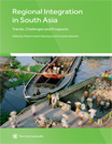 Regional Integration in South Asia: Trends, Challenges and ProspectsThis study presents an assessment of trade and economic cooperation among South Asian nations, explores emerging challenges, and highlights policy issues to foster regional integration. It provides perspectives on potential new areas of cooperation such as investment, regional supply chains, energy, and cross border transport networks. The four areas of focus are: potential gains from South Asian regional integration, key areas for cooperation resulting in effective regional integration, country perspectives of regional cooperation, and case studies on bilateral cooperation. This volume aims to further contribute to policy discourse on effective regional cooperation with perspectives from Bangladesh, India, Maldives, Nepal, Pakistan, and Sri Lanka.
Author: Mohammad A. Razzaque, Yurendra Basnett (Eds.) Year: 2014 Download Tags: South Asia, Regional Integration, Regional Cooperation, Bangladesh, India, Maldives, Nepal, Sri Lanka, Energy Statistical Yearbook for Asia and the Pacific 2014The Statistical Yearbook contains comparative statistics and facts about the 58 regional members and associate members of the Economic and Social Commission for Asia and the Pacific. It includes brief analyses of 32 key development features such as energy supply and use, international trade, and transport, among others. In energy, the region’s production structure is highly resource-intensive, although per capita energy use is low. The section on international trade recommends focusing on raising domestic value-added rather than increasing gross exports in Asia and the Pacific. Finally, investment in environmentally sustainable transport is encouraged. Author: United Nations Economic and Social Commission for Asia and the Pacific Year: 2014 Download Tags: Asia-Pacific, Energy, Trade, Transport, Bangladesh, Bhutan, India, Maldives, Nepal, Sri Lanka NTMs in South Asia: Assessment and AnalysisThe study “NTMs in South Asia: Assessment and Analysis” analyzes how Non-tariff Measures (NTMs) give rise to non-tariff barriers, which are becoming increasingly crucial for advancing trade cooperation among member countries of the South Asian Association for Regional Cooperation, yet remain less-addressed. The study examines export potential and actual export of South Asian countries, and attempts to highlight gains from reduction in transaction costs in bilateral trade. It also notes that initiatives for trade facilitation reforms in South Asia at the regional level remain low in incentives and have yet to produce significant results. The study closes with several recommendations for reducing and eliminating NTMs. Author: Selim Raihan, Mostafa Abid Khan, and Shaquib Quoreshi Year: 2014 Download Tags: Trade Facilitation, Trade, SAARC, Bangladesh, Bhutan, India, Maldives, Nepal, South Asia, Sri Lanka 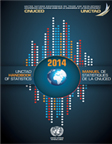 UNCTAD Handbook of Statistics 2014The UNCTAD Handbook of Statistics is a collection of statistics and indicators relevant to the analysis of international trade, investment and development. The 2014 edition shows the increasing convergence of trade balance between developing and developed economies continues. The report also includes regional trade data from South Asia that shows average annual growth rate of international trade improved from a previous deficit of -7.1% in 2012 to -0.1% in 2013. However, trade balance ran a deficit of -26.51% compared to the previous year's -25.94%. Trade indicators also report intra-trade in South Asian Association for Regional Cooperation region rose modestly from US$ 20,219 million to US$ 23,181 million between 2012 to 2013 and maintains intra-regional trade percentage at 5.8%. Author: United Nations Conference on Trade and Development Year: 2014 Download Tags: UNCTAD, Regional Trade, Development, Bangladesh, Bhutan, India, Maldives, Nepal, Sri Lanka, Transport 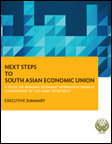 Next Steps to South Asian Economic UnionThis executive summary focuses on Phase II of the study on Regional Economic Integration, commissioned by the South Asian Association for Regional Cooperation (SAARC) Secretariat with the technical and financial assistance of the Asian Development Bank, and outlines a roadmap toward a South Asian Economic Union (SAEU). It presents an overview of intra-regional trade in South Asia—with India accounting for 65% of the region's combined total exports, and Sri Lanka 24% of total intra-regional imports—and discusses specific priority steps, using a phased and planned approach that quantifies potential gains from priority sectors identified in Phase I, needed to achieve regional economic integration. Thus, while non-tariff barriers, infrastructure constraints and other factors continue to challenge regional cooperation and integration in South Asia, reference by SAARC leaders toward an SAEU indicates a willingness to consider bold action. Author: Asian Development Bank Year: 2014 Download Tags: SAARC, South Asian Economic Union, Economic Integration, Bangladesh, Bhutan, India, Maldives, Nepal, Sri Lanka, Regional Integration Review of Maritime Transport 2014The Review of Maritime Transport is an annual UNCTAD flagship publication since 1968. It provides analysis of structural and cyclical changes affecting seaborne trade, ports and shipping, freight markets, and transport and regulatory frameworks. It further presents statistics, data, and insights on ownership of the world fleet, with South Asia dominating the market for ship recycling. This year’s special chapter focuses on the challenges faced by the world’s Small Island Developing States (SIDS) and reviews shipping-related challenges resulting from SIDS size, remoteness, and exposure to natural hazards, including impacts of climate change. Author: United Nations Conference on Trade and Development Year: 2014 Download Tags: Transport, Ports, Small Island Developing States, UNCTAD, Trade, South Asia, Bangladesh, India, Maldives, Sri Lanka Asian Economic Integration Monitor: November 2014This AEIM review of recent economic performance highlights the need for Asia to rebalance its sources of growth toward domestic and regional demand. It also shows a resilient Asia with rising GDP growth in South Asia. This issue includes a Special Chapter: Regional Financial Integration and Crisis in Asia and Europe – A Comparative Analysis. It presents Asia’s future path of integration as different from that in Europe. Asia will continue to strengthen efforts to harmonize rules and regulations in the financial sector and further unilateral trade and investment, while Europe is more likely to strengthen regional institutions to ensure recovery and better the monetary union. Author: Asian Development Bank Year: 2014 Download Tags: Asia-Pacific, Economic Integration, Europe, ASEAN, Bangladesh, Bhutan, India, Maldives, Nepal, Regional Integration, Sri Lanka, Trade Facilitation, Transport SASEC Website BrochureThis promotional brochure for the SASEC website features the web portal as a one-stop shop for information on SASEC activities, events, projects, and knowledge materials. The SASEC website seeks to build a dynamic discussion platform and repository of data on regional cooperation. Author: Asian Development Bank Year: 2014 Download Tags: SASEC, Knowledge Product, ICT, ADB, Bangladesh, Bhutan, India, Maldives, Nepal, South Asia, Transport, Trade Facilitation, Energy SASEC BrochureThis promotional brochure is a concise introduction to the South Asia Subregional Economic Cooperation (SASEC) Program, highlighting the main areas of regional cooperation and activity. It includes facts and figures about SASEC projects in transport, trade facilitation, energy, and ICT. Author: Asian Development Bank Year: 2014 Download Tags: SASEC, Trade Facilitation, Regional Cooperation, ICT, ADB, Bangladesh, Bhutan, India, Nepal, Maldives, Sri Lanka, Energy, Transport, Connectivity, Myanmar 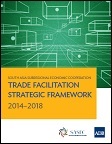 SASEC Trade Facilitation Strategic Framework 2014-2018The South Asia Subregional Economic Cooperation (SASEC) Trade Facilitation Strategic Framework 2014-2018 builds on the momentum of member countries over recent years in forging ahead with many significant improvements to facilitate, and ultimately increase, trade in the subregion and with the rest of the world. It supports the mission of the SASEC Transport and Trade Facilitation Strategy “to promote the prosperity of the subregion by facilitating the efficient movement of trade across the borders”, and focuses on five priority areas: customs modernization and harmonization; standards and conformity assessment strengthening; cross-border facilities improvement; through-transport facilitation; and institution and capacity building. Author: Asian Development Bank Year: 2014 Download Tags: SASEC, Trade Facilitation, Regional Cooperation, Transport, Trade, Customs, Standards, Harmonisation, Regional Integration, ADB, Bangladesh, Bhutan, India, Maldives, Nepal, Sri Lanka, South Asia, ADB RCI World Trade Report 2014 – Trade and Development: Recent Trends and the Role of the WTOThis annual publication highlights the relationship between trade and development, including changes since the start of the millennium. It identifies four key trends that altered the way trade affects development outcomes – accelerated economic growth in developing countries, expansion of global value chains, increase in agricultural and natural resource prices, and global nature of macroeconomic shocks. This report also explores how these trends have reshaped the role of trade in facilitating development and how recent development gains allow developing countries to adapt and mitigate risks. Author: World Trade Organization Year: 2014 Download Tags: WTO, Global Value Chains, Trade, Economic Growth, Agriculture, Trade Facilitation, Development, Bangladesh, Bhutan, India, Maldives, Nepal, South Asia, Sri Lanka South Asia Economic Focus: The Export OpportunityThis bi-annual report presents the recent economic developments, outlook, and policy of the following South Asian countries – Afghanistan, Bangladesh, Bhutan, India, the Maldives, Nepal, Pakistan, and Sri Lanka. It highlights developing country growth as fairly robust. Meanwhile, India’s growth rate is slowly increasing and its inflation rate declining. South Asian economies solidified their external positions by easing pressures to finance current account deficits, yet face domestic challenges such as reducing fiscal risks, supporting higher levels of investment, and sustaining export growth. Author: The World Bank Year: 2014 Download Tags: South Asia, Trade, Economics, WB, Bangladesh, Bhutan, India, Maldives, Nepal, Sri Lanka Port Management Series Volume 1: Port Management Case StudiesThis publication presents summaries of the best three dissertations from the past cycle of the English-speaking network of the Train-for-Trade Port Training Program (2011-2013). This United Nations Conference on Trade and Development Train-For-Trade Port Training Programme supports port communities in developing countries achieve efficient and competitive port management. The findings of the Maldives study reveal the possibility of reducing port maintenance by 15% of total operating costs through adherence to a maintenance schedule, standardizing equipment in procurement policy, updating maintenance requirements and available equipment, and recording maintenance expenditure. Author: United Nations Conference on Trade and Development Year: 2014 Download Tags: Maldives, Transport, Ports Impact of Trade Facilitation on Foreign Direct InvestmentThis United Nations Economic and Social Commission for Asia and the Pacific Trade and Investment Working Paper attempts to quantify the potential impact of trade facilitation on foreign direct investment (FDI) flows. The study uses bilateral FDI data from 2006 onward from both developing and developed countries, including South-South FDI flows, wherein contiguity (common border between source and host country) and geographic distance are found to be much more important factors. In applying an augmented FDI model framework to determine the effect of comprehensive international trade costs, the results show that both non-tariff and tariff costs are important determinants of FDI inflows. Author: Yann Duval and Chorthip Utoktham Year: 2014 Download Tags: FDI, Trade Facilitation, Bilateral Trade, UNESCAP, Investment, Tariff, Bangladesh, Maldives Economic and Social Survey of Asia and the Pacific 2014This 2014 edition of UNESCAP's flagship publication emphasizes the importance of furthering regional connectivity in Asia-Pacific—a region which, despite significant reductions in poverty levels, is now witnessing rising income inequality, both within and between countries. It calls for driving the region's growth by exploiting the interdependence and synergies of five elements: trade and transport connectivity, ICT networks, energy connectivity, people-to-people networks, and promotion of knowledge-based economies, and advocates approaching connectivity as a regional public good. Author: UNESCAP Year: 2014 Download Tags: Economic Integration, Regional Cooperation, Poverty Reduction, Asia-Pacific, Connectivity, Energy, ICT, Bangladesh, Bhutan, India, Maldives, Sri Lanka, Trade, Transport, UNESCAP 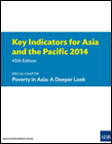 Key Indicators for Asia and the Pacific 2014This year's edition presents an in-depth inquiry on poverty in Asia, tackling whether the $1.25/day extreme poverty standard still accurately depicts minimum living standard of the poor in Asia and the Pacific. Using this broad measure, the poverty rate is projected to fall to 24.5% for South Asia by 2030, if recent economic growth trends continue. However, considering the current national poverty line average among today's less developed economies in the region, an Asia-specific extreme poverty line is more accurately estimated at $1.51/day, increasing Asia’s poverty rate in 2010 by 9.8%, and ��of a large economy like India by 15%. Hence, despite huge gains made, reducing poverty remains a pressing challenge in Asia and the Pacific. This book proposes several measures to counteract worsening poverty, including �close �regional cooperation which can reduce a country’s vulnerability, and urgent policy actions that promote economic growth and prioritize climate change adaptation and mitigation. Author: Asian Development Bank Year: 2014 Download Tags: Poverty Reduction, Disaster Risk, Regional Cooperation, Asia-Pacific, Bangladesh, Bhutan, Economics, Energy, India, Maldives, Milennium Development Goals, Nepal, Sri Lanka, Sustainability, Transport Assessing the Costs of Climate Change and Adaptation in South AsiaThis book discusses the economic costs and benefits of unilateral and regional actors on climate change adaptation in Bangladesh, Bhutan, India, the Maldives, Nepal, and Sri Lanka. It provides the total economic loss throughout the 21st century and estimates the funding required for adaptation measures to avert potential losses. Huge impacts are likely on vulnerable sectors in the region, with South Asia losing on average nearly 2% of its gross domestic product by 2050. Results of the study will aid climate change adaptation in the region, including initiatives for regional cooperation. Author: Mahfuz Ahmed and Suphachol Suphachalasai Year: 2014 Download Tags: Climate, South Asia, Regional Cooperation, Energy, Bangladesh, Bhutan, India, Maldives, Nepal, Sri Lanka 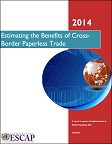 Estimating the Benefits of Cross-Border Paperless TradeCross-border paperless trade is trade that occurs on the basis of electronic communications and has been part of customs reform efforts in a variety of countries. Increased implementation of cross-border paperless trade is high on the trade facilitation agenda in Asia-Pacific. This report considers six measures to calculate estimates of possible economic benefits of cross-border paperless trade through counterfactual simulations using 2013 data and simple econometric models. Simulation results reveal that this new generation of trade facilitation can significantly reduce trade costs and boost intra- and extra-regional trade in the region. Partial implementation of these measures can lead to an export increase of $36 billion annually. Total direct cost savings across all trade is about $1 billion per annum for partial reform, and $7 billion for full implementation. Author: United Nations Economic and Social Commission for Asia and the Pacific Year: 2014 Download Tags: Trade Facilitation, Trade, Asia-Pacific, UNESCAP, Customs, Export, Bangladesh, Bhutan, India, Maldives, Nepal, Sri Lanka Trade Facilitation and Paperless Trade ImplementationThis paper reports survey findings on progress in implementing various trade facilitation and paperless trade measures made by 29 countries in Asia and the Pacific, including six SASEC member countries. Factors considered include pre-arrival clearance, post-clearance audit, National Single Window, and authorized operator programmes. The survey reveals that while countries have prioritized automation and paperless trade at the regional level, there is an urgent need for regional arrangements that will facilitate cross-border exchange of trade-related electronic documents and information to enable smoother trade facilitation. Author: Tengfei Wang and Yann Duval Year: 2014 Download Tags: Trade Facilitation, Regional Cooperation, Trade, Asia-Pacific, SASEC, Single Window, UNESCAP, Customs, Bangladesh, Bhutan, India, Maldives, Nepal, Sri Lanka Asian Development Outlook 2014: Fiscal Policy for Inclusive GrowthThe Asian Development Outlook, ADB’s flagship economic publication provides comprehensive macroeconomic analysis in Asia including growth projections by country and region. The Asian Development Outlook 2014 forecasts that developing Asia will grow 6.2% in 2014 and 6.4% in 2015. South Asia remains one of the slowest growing subregions—although growth is forecast to improve by 5.3% in 2014 and 5.8% in 2015. Author: Asian Development Bank Year: 2014 Download Tags: ADB, Bangladesh, Bhutan, Economic Corridor, Energy, India, Maldives, Nepal, Sri Lanka, Transport 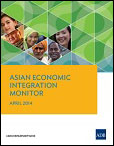 Asian Economic Integration Monitor - April 2014The Asian Economic Integration Monitor, a semiannual review of regional economic cooperation and integration in Asia covers regional economic updates, intraregional trade, financial integration and investment, and the importance of disaster risk financing instruments. The Theme Chapter: Insuring Against Asia’s Natural Catastrophes discusses market solutions and the role of government in developing disaster risk financing and strengthening financial resilience. The economic update section encourages strengthening regional cooperation in surveillance and financial safety nets, and deepening economic links. Inter-subregional trade between each subregion and the rest of Asia is rising, except in South Asia, while financial integration continues to deepen across the region. Author: Asian Development Bank Year: 2014 Download Tags: Regional Cooperation, Regional Integration, South Asia, Disaster Risk, Climate, Bangladesh, Bhutan, India, Maldives, Nepal, Sri Lanka, Transport Asian Market Development and Integration: Challenges and OpportunitiesThis book, co-published by Asian Development Bank (ADB) and Korea Capital Market Institute (KCMI), in collaboration with the Peterson Institute for International Economics, examines the path of capital market development in Asia since the 2008 global crisis. It presents the analytical framework for addressing capital market integration at the regional level and its likely impacts. Author: Asian Development Bank (ADB) and Korea Capital Market Institute(KCMI), eds. Year: 2014 Download Tags: Economics, Trade Policy, Regional Integration, Bangladesh, Bhutan, India, Maldives, Nepal, Sri Lanka Reducing Poverty by Closing South Asia's Infrastructure GapThis report takes a critical look at inter-and intra-regional infrastructure of South Asia and explores inequality of access across space and time. It gives an approximate total cost of regional infrastructure needs and investment trends in the South Asia region, along with a proposed framework on ranking of infrastructure needs. The report also examines better usage of existing resources and policy options to help the poorest gain better access to infrastructure.
Finally, it recognizes the enormity of infrastructure deficiencies in South Asia and acknowledges that a good mix of infrastructure investment and supportive reform implementation will enable the region to close the infrastructure gap. Author: Luis Andrés, Dan Biller, and Matías Herrera Dappe Year: 2013 Download Tags: Transport, South Asia, Infrastructure, Energy, Roads, Railway, Water Supply, Bangladesh, Bhutan, Nepal, India, Sri Lanka, Maldives ADB Regional Cooperation Operations Business Plan (RCOBP) 2014-2016 for South AsiaADB's third Regional Cooperation Operations Business Plan (RCOBP) 2014-2016 for South Asia under its South Asia Regional Cooperation Strategy (RCS) 2011-2015 details a cumulative indicative lending program of $3.3 billion and maintains focus on improved regional connectivity, increased cross-border trade, and strengthened regional economic cooperation. Author: Asian Development Bank Year: 2013 Download Tags: Regional Cooperation, Regional Integration, Bangladesh, Bhutan, India, Maldives, Nepal, Sri Lanka, Trade Facilitation, Transport, Energy, SAARC Financing Low-Carbon UrbanDevelopment in South Asia: A Post-2012 Context The cities of South Asia are growing at an unprecedented rate. Currently, the region
accounts for 5 of the world's 26 megacities (Delhi, Dhaka, Karachi, Kolkata, and
Mumbai),with Kolkata and Mumbai being the most dense. The urban population in
India is expected to increase by 20.8 percentage points between 2010 and 2050 compared
to 7.8 percentage points in Latin America and the Caribbean. These trends necessitate bold
efforts in project design and financing to steer this rapid urbanization onto an inclusive, green,
and low-carbon urban development path. Author: Asian Development Bank Year: 2013 Download Tags: Climate, Energy, India, South Asia, Kyoto Protocol, Bangladesh, Bhutan, Nepal, India, Maldives, Sri Lanka Aid for Trade: An Investment Benefit Road Map for South AsiaAid for Trade (AfT) came to prominence just over a decade ago at the launch of the
World Trade Organization's Doha Round. With its focus on helping least developed
countries and economies escape the poverty trap, it aims to strengthen their
capabilities to meet market demand and to reduce supply-side constraints such as a lack of
trade infrastructure. Author: Asian Development Bank Year: 2013 Download Tags: Trade Policy, Poverty Reduction, Infrastructure, India, Bangladesh, Bhutan, Maldives, Sri Lanka, Nepal, Trade Facilitation, Transport, Global Value Chains, Exports Energy Outlook for Asia and the Pacific: October 2013The Energy Outlook for Asia and the Pacific aims to support ADB energy sector operations
by providing stakeholders with an energy outlook for the region up to the year 2035.
It attempts to identify policy, social, infrastructure, and technology issues that must be
addressed to meet future energy need of ADB members in Asia and the Pacific. Author: Asian Development Bank Year: 2013 Download Tags: Energy, Infrastructure, Renewables, Hydropower, Transport, Bangladesh, Bhutan, India, Nepal, Maldives, Sri Lanka Climate Action South Asia: Information Update No. 3 (The Economics of Climate Change in South Asia: Adaptation and Impact Assessment)Analyses show that the cost of early action on climate change in South Asia is lower than
the cost of damage brought about by climate change impacts. In physical terms, the region
will face water shortage and agricultural food production losses, which are vital to achieving
poverty reduction and other Millennium Development Goals (MDGs). Author: Asian Development Bank Year: 2013 Download Tags: Economics, Climate, Agriculture, Climate Change, Environment, South Asia, Milennium Development Goals, Sustainability, Bangladesh, Bhutan, India, Nepal, Maldives, Poverty Reduction, Hydropower, Energy Climate Action South Asia: Information Update No. 2 (Economics of Reducing Greenhouse Gas Emissions in South Asia: Options and Costs)The study Economics of Reducing Greenhouse Gas Emissions: Options and Costs in Bangladesh, Bhutan, the Maldives, Nepal, and Sri Lanka reveals excellent opportunities in low-carbon green growth by pursuing resource- and energyefficient technologies that would lower emissions of greenhouse gases at low cost or even cost saving (benefits). Author: Asian Development Bank Year: 2013 Download Tags: Economics, Climate, Climate Change, Economics, South Asia, Bangladesh, Bhutan, Maldives, Sri Lanka, Energy, Environment, Sustainability, ADB, Nepal, Development, Hydropower 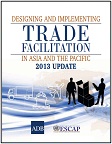 Designing and Implementing Trade Facilitation in Asia and the PacificThis reference book was published to support the implementation of trade facilitation measures and reforms in Asia and the Pacific. It includes operational guidance on assessing the status of trade facilitation, the measures and reforms needed, how to design trade facilitation initiatives, and how to implement them at national and regional levels. The book is intended to assist policy makers, practitioners, and economists by bridging the gap between theory and practice. The revised 2013 version includes updated statistical figures and data, information on actual trade facilitation policies and practices, and the most recent research on trade facilitation. Author: Asian Development Bank / United Nations Economic and Social Commission for Asia and the Pacific Year: 2013 Download Tags: Trade Facilitation, Regional Cooperation, Regional Integration, Trade Policy, Economic Corridor, Sanitary and Phytosanitary Measures, Technical Barriers to Trade, Revised Kyoto Convention, Customs, Customs Valuation, Bangladesh, Bhutan, India, Nepal, Maldives, Sri Lanka, Services Asia-Pacific Trade Facilitation Forum: Survey on Trade Facilitation and Paperless TradeConducted jointly by the Asian Development Bank and the United Nations Economic and Social Commission for Asia and the Pacific, this survey provides a status snapshot of trade facilitation in place across 26 countries of the region, including progress towards establishment of national trade facilitation committees, implementation of risk management measures, development of national single windows, and steps taken to move toward paperless trade. It further examines specific issues and challenges in these areas of South East Asian countries, and provides recommendations for improvement. Author: ADB and UNESCAP Year: 2012 Download Tags: Trade Facilitation, Paperless Trade, Bangladesh, Bhutan, India, Nepal, Maldives, Sri Lanka, Customs, Transport Facilitation, Myanmar, National Single Window Regional Integration and Economic Development in South AsiaSouth Asian leaders have made it a priority to tackle key regional issues such as poverty, environment degradation, trade and investment barriers and food insecurity, among others. This book considers the leadership of the South Asian Association for Regional Cooperation (SAARC) and the interaction with civil society in the process of South Asian regional cooperation and integration, and discusses how the emerging urgency in the provision of regional public goods provides an excellent opportunity to add to the successes in South Asian regional integration. Author: Sultan Hafeez / Rahman Sridhar Khatri / Hans-Peter Brunner Year: 2012 Download Tags: Economic Corridor, Regional Cooperation, Regional Integration, SAARC, SAFTA, Bangladesh, Bhutan, India, Maldives, Nepal, Sri Lanka Sector Roadmaps with Result FrameworksSector roadmaps with result frameworks for transport, energy, and trade facilitation. Author: Asian Development Bank Year: 2011 Download Tags: Trade Facilitation, Energy, Transport, Bangladesh, Bhutan, India, Maldives, Nepal, Sri Lanka Regional Cooperation and Integration Through Cross-Border Insfrastructure Development in South AsiaThis paper aims to identify the links between cross-border infrastructure development and poverty reduction. With South Asia being home to around 40% of the world's poor, there is a great need to boost intraregional trade through greater cooperation and integration. Regional integration promises to increase the region's capacity to connect with global production networks and participate in the global economy with greater efficiency. Author: P.V. Srinivasan Year: 2011 Download Tags: Regional Cooperation, Regional Integration, South Asia, Bangladesh, Bhutan, India, Maldives, Nepal, Sri Lanka, Poverty Reduction South Asia- Intra Regional Cooperation: The Way ForwardThis study aims to showcase the benefits of regional integration and recommends strategies for overcoming the many hurdles. Author: Shahid Kardar Year: 2011 Download Tags: Policy, Economic Cooperation, Regional Integration, Development, SAARC, Non-Tariff Measures, Trade Facilitation, SAFTA, India, Bangladesh, Bhutan, Maldives, Nepal, Sri Lanka, BIMSTEC, Myanmar, SASEC, Energy 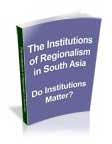 The Institutions of Regionalism in South Asia - Do Institutions Matter?This paper assesses the contribution of key institutions of regional cooperation and integration (RCI) in South Asia, and suggests ways in which the Asian Development Bank and other development partners can strengthen their support. It attempts to enhance understanding on the interplay between politics and RCI, including how good bilateral political relations or improvements have advanced RCI. With the overall political environment growing increasingly open to RCI, the paper suggests the time has come for the South Asian Association for Regional Cooperation (SAARC) to consider strengthening the capacity of the SAARC Secretariat to meet the growing challenges and work load of managing the anticipated increase in RCI. Author: Prabhu Ghate Year: 2011 Download Tags: Regional Cooperation, Regional Integration, Development, SAARC, Trade, Services, Trade Facilitation, Energy, Free Trade Agreements, SAFTA, Bangladesh, Bhutan, India, Maldives, Nepal, Sri Lanka, Transport Energy Trade in South Asia: Opportunities and ChallengesThe South Asia Regional Energy Study was completed as an important component of the regional technical assistance project Preparing the Energy Sector Dialogue and South Asian Association for Regional Cooperation Energy Center Capacity Development. It involved examining regional energy trade opportunities among all the member states of the South Asian Association for Regional Cooperation. The study provides interventions to improve regional energy cooperation in different timescales, including specific infrastructure projects which can be implemented during these periods. Author: Sultan Hafeez Rahman / Priyantha D. C. Wijayatunga / Herath Gunatilake / P. N. Fernando Year: 2011 Download Tags: Energy, Regional Cooperation, Regional Integration, SAARC, Trade, Bangladesh, Bhutan, India, Nepal, Maldives, Sri Lanka The Provision of Regional Public Goods in South AsiaThis report reviews the provision of high priority regional public goods (RPGs) selected
for the South Asia subregion, and proposes areas of cooperation for improving the provisioning of RPGs in South Asia. It highlights the issues in cross border management of infrastructure projects and best practices in the provisioning of RPGs relevant for South Asia, evaluates ADB’s contributions to providing RPGs in the subregion, and concludes with recommendations on ADB’s South Asia Regional Department’s role in the provision of RPGs in the subregion. Author: Khaja Moinuddin Year: 2010 Download Tags: Energy, Agriculture, Disaster Risk, Governance, Poverty Reduction, Bangladesh, Bhutan, India, Maldives, Nepal, Sri Lanka, Trade Facilitation, Transport Binding Contraints to Regional Cooperation and Integration in South AsiaThis paper examines the benefits of regional cooperation and integration, focusing on the cost of neglecting to address the binding constraints to regional cooperation and integration. Component papers in this volume analyze the current state of play, and identifies the binding constraints to achieving more efficient transport corridors, regional energy trade and trade facilitation in the region. Author: Gilberto M. Llanto Year: 2010 Download Tags: Regional Cooperation, Economic Integration, Trade Facilitation, Energy, Bangladesh, Bhutan, India, Maldives, Nepal, Sri Lanka, Transport Infrastructure for a Seamless AsiaThe study reviews regional infrastructure being enhanced through regional cooperation in Asia and examines major issues and challenges. It suggests a framework for pan-Asian infrastructure cooperation, anchored on a long-term vision of creating a seamless Asia that will not only enhance the region's competitiveness and extend its global reach, but also help reduce poverty and promote greater environmental sustainability. Author: Asian Development Bank / Asian Development Bank Institute Year: 2009 Download Tags: Regional Cooperation, Regional Integration, Transport, Trade Facilitation, Connectivity, India, Bangladesh, Bhutan, Nepal, Maldives, Sri Lanka, Asian Highway, Trans-Asian Railway Network, Energy, Myanmar Quantification of Benefits from Economic Cooperation in South AsiaThe study examines the implication of the South Asian Free Trade Agreement (SAFTA) on South Asian countries and on the region as a whole, employing both a quantitative and qualitative assessment on the outcomes of SAFTA. The research aims to provide support in the formulation of concrete policy measures for trade to ensure greater gains for the region, while at the same time mitigating potential negative impacts. Economic and social assessments through analytical tools and rational causal chain analysis further enrich the study. Author: Asian Development Bank / United Nations Conference on Trade and Development Year: 2008 Download Tags: Economic Corridor, Regional Cooperation, Regional Integration, SAFTA, Free Trade Agreements, Trade Facilitation, Transport, Services, SAARC, Bangladesh, Bhutan, India, Maldives, Nepal, Sri Lanka Emerging Asian Regionalism-A Partnership for Shared ProsperityThe study summarizes important issues related to Asian regionalism. Viewing regional cooperation as a necessary tool for coping with the consequences of interdependence, the book discusses several pressing issues, such as integrating production, improving financial cooperation, and managing macroeconomic interdependence to create a stable architecture for an Asia-wide cooperation. Author: Asian Development Bank Year: 2008 Download Tags: Economic Corridor, Regional Cooperation, Regional Integration, Asia, ASEAN, SAARC, Bangladesh, Bhutan, India, Nepal, Maldives, Sri Lanka |



